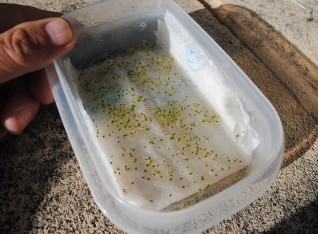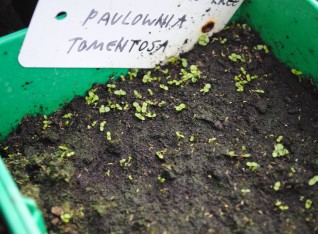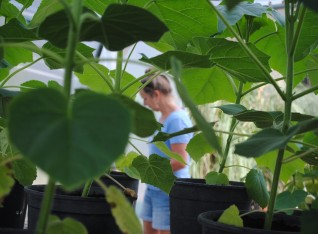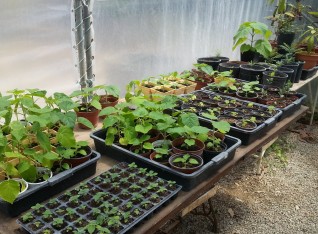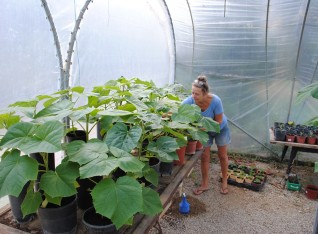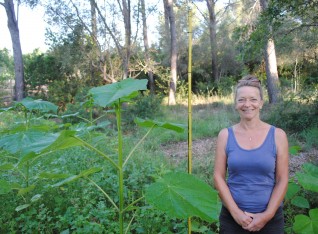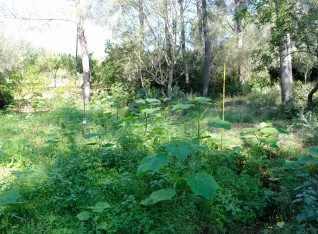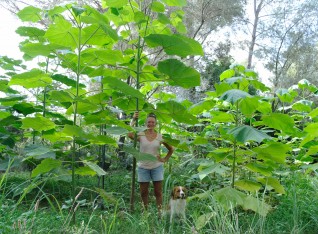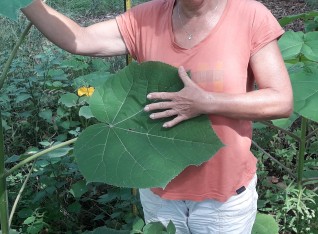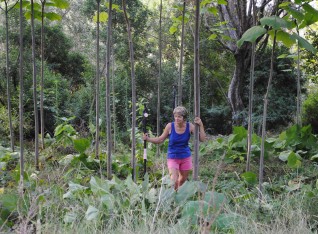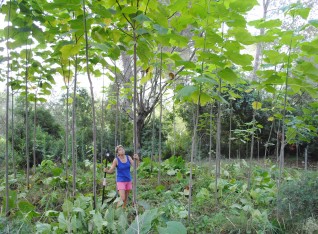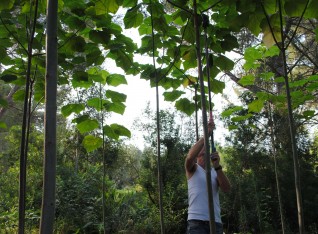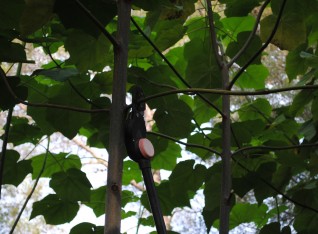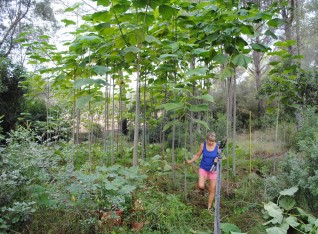Paulownia Tomentosa rain forest (update)
August 3, 2018To attract more new hosts for Hovos we started an advertising campaign offering new hosts a welcome-bonus of $10. This proves to work rather well, yesterday alone we had 10 new host signups, all having interesting projects and of course needing help from traveling volunteers. One of the new hosts is from New South Wales who owns a 77 hectares estate. The title of his profile caught my attention:
Herbicide free Regenerating Rain Forest... but there were no photos, so I send Donald - the owner of the host profile - a message about this and advised him to add photos as this would for sure boost the attention his profile generated on Hovos. But being curious already I dug a bit deeper and found his website where he keeps a blog and posts new articles regularly (https://herbicidefree.co). On July 24 he wrote about a part of his property which he reforested with fast growing Pencil Cedars which grow 3 meter tall in just 1 year. This looks very much like the experimental Paulownia Tomentosa mini rain forest which we are creating and which also this year does exceptionally well.
Second year: from 4 meter to 8 meter
Last year I sprinkled the mini rain forest from above, which luckily Paulownias do not mind - the limestone in the water does not deposit on the leaves of these trees, which is surprising because the leaves have little tiny hairs which feel like velvet. Last year I installed a steel galvanized tube in the stump of one of the pine trees which had been cut of about 6 meter. For this year this was not enough so I cut this pole to about 2 meter and installed a sprinkler on top of it. The trees had grown tall enough and the lower branches were cut, so now we can sprinkle from below the canopy. This works very well, every 6 hours we turn the irrigation on for 15 minutes (3 sprinklers cover the whole mini rain forest). Birds love it and the undergrowth does also very well with young avocado trees, fig trees, hollyhock and various other species. We now intend to give it an even more tropical look by adding ferns, mini feather palms and maybe we plant some vines near the Paulownias like the Solardra Maxima - which has beautiful large trumpet flowers and has a very lush appearance.
Pencil Cedar: seeds are on it's way from Aussie Land !
I got intrigued by the Pencil Cedar for it's fast growing in the first place. I google a bit and quickly found seeds on eBay and ordered a few from an Australian seller. So they are on it\'s way now. The tree needs a subtropical climate, which Mallorca could offer. Often it\'s not the high temperature which decides whether or not a plant or tree can survive somewhere, but the lowest temperatures which can be expected. We have more native Australian trees which are doing well here like the Paperbark tree and the Jacaranda. But another tree which does not very well is the Macadamia, not really endemic to Australia, but it\'s doing very well in regions like Queensland. We have 3 of these trees and they are not thriving at all, although we did get a few nuts from it, small ones.I asked the Australian host if he had ever heard of Paulownias and he wrote me back that he did, quote:
"Paulownia was planted on a nearby site to here but was removed when it
started to take over. There is a mind set here that seems to proceed
1788 and the arrival of the first fleet onto the Australian land mass.
Along with that first, second and third fleet, came the numerous
European plants that now occupy Australia. I read Fred Pearce's THE NEW
WILD who argues that with climate change, the planet will need every
plant the adapts and survives to fill the niches humans have created."Especially Australia and New Zealand are over the top afraid of getting non-endemic plants to their country. Although I can understand this, but this black and white thinking should not apply to Paulownias. The tag 'invasive' is being used quickly if a plant can reproduce itself. Here - on Mallorca - Paulownias do not reproduce itself, probably because the seeds spread itself from the seed capsules in December when it's too cold here to germinate (it needs a temperature of around 25 Celsius to germinate). What it does do however is grow itself again from a stump. So if you would harvest a Paulownia field with a trunk diameter of say 35 cm, you would see that it grows from this stump to 4 meter within a year. So once you have a Paulownia forest you can harvest it every 15 years or so without having to go through the baby phase of the tree.
Soil: in many cases the weakest link
Before we bought La Mina SC I did not have 'green fingers' at all. Simply because I have never had a garden as born and raised as a city boy. But this changed instantly here on Mallorca and I have learned a lot over the years we are here. Many things can be learned from the internet, but some things you have to just experience. Like with the importance of the soil. Most important for soil is that roots are able to penetrate it. Some trees have no problem with finding the way to water like pine trees, others have more softer roots and need loose soil. Four years ago we transformed a 1000 m2 piece of land in the vineyard. After planting the vines there was one very fast growing plant which we did not know what it was till it became much larger: Castor Bean. It grew 4 meter tall in just 1 year, with large reddish beautiful kind of Marijuana shaped leaves. It really looked like a very tropical tree. The first year the stem was still hollow, just like the Paulownias. We had to cut it as it took away too much sun from the vines, but we found other Castor beans near Colonia San Pedro. With seeds, so we collected many of them. The seeds look like a tick which has sucked itself full of blood. This is the reason for it's Latin name which includes 'ricine' which is also the name of the poison inside these beans (1 milligram of this poison can kill you). The seeds are very easy to germinate and soon we had many small Castor Bean plants. When they grew larger we planted them out in many places on our land. It surprised us that they never thrived as good as the first one did. The same problem we had with the Paulownias. These germinate also quite easily and grow very fast in pots, but when we planted them out in our intended jungle area they did not well at all. Soil and water are the most important reasons why they did not do well. The soil in our current mini rain forest with the Paulownias however is doing great for the opposite reason. I remember that David - the former owner of La Mina SC - told me that that piece of land contained good soil, no rocks, no piedra. If we really want to continue with creating a lush jungle here we need to add maybe up to 2 meter of good soil, so this would involve many truckloads. But this is really the solution and the weakest link on our terrain. We have an unlimited water supply, irrigation systems everywhere, enough sun and enough warm weather and not to cold in Winter, but what we lack here is a good layer of lose and penetratable soil.
